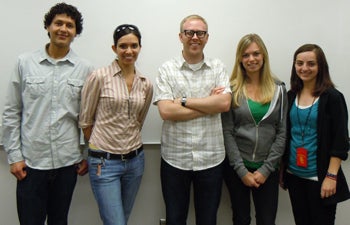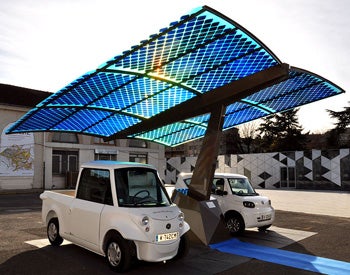Climbing the STEM of Success
Jose Araujo had never considered going to graduate school for the simple reason he wasn’t aware it existed. The son of a construction worker, Araujo is today a first-generation college student in USC Dornsife.
Araujo was attending Cerritos Community College in Norwalk, Los Angeles County, when he heard about USC Dornsife’s paid Summer Research Internship in Solar Energy. He had always loved science and decided to apply. After participating in the eight-week program, the brainchild of USC Dornsife chemistry professors Richard Brutchey, Stephen Bradforth and Mark Thompson, Araujo found his academic ambitions and life goals were transformed.
“I got hands-on experience that helped reinforce my interest in chemistry and made me begin to understand the value of being able to do undergraduate research at school,” Araujo said. “The program definitely motivated me to apply to four-year universities, especially research universities. I also know now that I want to go to graduate school.”
The community college transfer student is majoring in chemistry, holds down a job in the chemistry labs and is planning to pursue a graduate degree and a career in science. None of that would have happened, he said, if it hadn’t been for that summer internship and the resulting support and mentorship he received from Brutchey and his team.
“My family wasn’t against higher education, but they just didn’t know how to be supportive of me being a college student,” Araujo said. “They weren’t able to offer me advice on universities or transferring or any of that either.
“To be honest, I would never even have applied to USC if I hadn’t participated in the program,” Araujo confessed. “I always thought going to USC was something unreachable because it’s a private university and I thought it would be too expensive. Even after I was accepted I wasn’t going to come because I didn’t think there was anyway I was going to be able to afford it.”
Thanks to Brutchey’s encouragement, Araujo applied for and got a generous financial aid package.

Richard Brutchey, associate professor of chemistry in USC Dornsife (center) with Jose Araujo and Hannah Hinton, both students from Cerritos Community College who successfully participated in the solar energy internship. Also pictured are Priscilla Antunez and Jannise Buckley, graduate students in the chemistry Ph.D. program and recipients of NSF graduate fellowships, who acted as mentors to the interns. From left: Araujo, Antunez, Brutchey, Buckley and Hinton. Photo by Jeff Bradbury.
“He took some convincing,” Brutchey laughed. “I told him it can’t hurt to try. He did and it worked out. He’s doing really well in his classes, he has been working in my lab and he’s doing a work/study program and managing to do it all successfully.”
Founded three years ago by Brutchey, Bradforth and Thompson, the internship program is designed to help minority students in the community college system — a group which studies show are at particularly high risk of dropping out without completing a degree.
Many students in California’s vast community college system, particularly minorities, struggle to graduate or transfer to four-year universities. According to a recent study of California’s community colleges, 80 percent of Latino and 75 percent of African American students have not completed a community college degree or certificate after six years.
“These statistics made us think about what a tier-one research university like USC could do to help,” said Brutchey, associate professor of chemistry. “We noticed that while there were many outreach programs in chemical sciences for K-12 students, there was a lack of outreach activity directed toward community college students for physical sciences, and specifically for the chemical sciences.”
The program is aimed at recruiting community college students to study fields in science, technology, engineering and mathematics (STEM).
“We thought that offering students in this situation an internship in science or engineering might motivate them to continue their studies.”
Their intuition proved correct. Of the seven students who have participated in the program, two are continuing their studies at community college and five have transferred to four-year universities to major in STEM disciplines. One of those students is going on to pharmacy school.
Another, Joseph Mastron, who transferred to USC Dornsife two years ago, will graduate this Spring and will enter a Ph.D. program in physical chemistry this Fall. He plans to continue his research into photovoltaics, a subject he discovered during his internship.
“The program was a life-changing event for me,” said Mastron. “In fact, it was the best event of my life.”
What he learned in the laboratory was invaluable, he said, and “shaped who I am today.”
Brutchey said that is the goal: to foster an interest in science and related careers by providing valuable hands on research training and intensive mentoring.
The program’s support was also a motivating factor for Araujo. He said the guidance he received from Brutchey and his mentor Priscilla Antunez, a National Science Foundation (NSF) graduate fellow, played a huge role in him transferring to USC Dornsife.
“They were very good mentors and patient teachers to me during the research program,” Araujo said. “I chose to transfer to USC Dornsife because I had such a great experience here during the summer internship. I liked the campus, the research and the professors.”
The internship is funded by the National Science Foundation and the Research Corporation for Science Advancement (RCSA), a private, independent foundation. Brutchey and Bradforth are both Cottrell Scholars, meaning they have received a major RCSA award which funds excellent scientists who also have a passion for teaching at leading United States research universities.
According to the Los Angeles Community College District, there are roughly 250,000 community college students in the greater Los Angeles area — one of the highest concentrations in the country.
Brutchey is sympathetic to what he believes are the underlying reasons why so many community college students are struggling to remain in higher education.
“Many of these students are in really difficult positions: they have to work, many of them have families, they have real lives on top of trying to attend school, so that’s probably why so many of them struggle. It’s a lot to handle,” he said. “So the first thing we decided was to make this a paid internship with the hope that the stipend we offer encourages them to do this, rather than take a side job for the summer.”
The outreach program currently focuses on Cerritos Community College (CCC). Located in south east L.A. County, CCC reportedly has the sixth largest population of Latino community college students in the nation. There, Brutchey and his colleagues work closely with CCC Chemistry Professor Jeff Bradbury, who helps select the students. To be eligible, students must be majoring in a scientific discipline and have completed a first-year chemistry course. Minorities and women, generally underrepresented in the physical sciences, are especially encouraged to apply.
The USC Dornsife professors chose solar cell research as the focus of the research internship.

Photovoltaic SUDI shade is an autonomous and mobile station in France that replenishes energy for electric vehicles using solar energy. In a USC Dornsife internship program, participants design and synthesize new molecules and materials for use in photovoltaic technology. (“Photovoltaic” refers to the direct conversion of light into electricity.)
“There is a core group of faculty within the chemistry department who work in this area and we thought it was an attractive topic for these students because it’s familiar to them,” Brutchey said.
By focusing on solar cell research, students also learn a great deal about nanoscience — a hot topic across a broad spectrum of cutting-edge chemistry and physics.
Program participants work with USC researchers to design and synthesize new molecules and materials for use in “organic” — basically plastic and therefore relatively affordable — photovoltaic technology. (“Photovoltaic” refers to the direct conversion of light into electricity.) In the process, students develop a first-hand understanding of the physical processes of energy capture, efficient energy conversion from sunlight to electricity and electrical charge collection.
The internship also touches on topics such as scientific ethics, implementing the scientific method in the research laboratory and career opportunities for scientists and engineers.
Brutchey and his colleagues certainly had no problem getting students interested in the program.
“Every year we go to CCC and give a general seminar on the world energy crisis, how alternative energy can help alleviate some of these problems and how solar cells can be part of the solution. We hold it during the lunch break and it’s open to all students. We’ve had great success attracting students to this lecture with upwards of a couple of hundred students showing up just out of general interest.”
Upon the students’ arrival at USC, Brutchey lets them know what he expects.
“Working in academia, working in a research lab is certainly different than working at a convenience store but we expect them to treat this as a job,” Brutchey said. “They have a research supervisor. We expect them to keep regular hours and put in 40 hours a week. And at the end we ask them to give a 15 minute research presentation of their data in front of their mentors and USC Dornsife and CCC faculty.
“All the students are able to meet these expectations and surpass them in many cases.”
Several former interns have published peer review papers and presented their work to national meetings of the American Chemical Society. Every student who has completed their units at Cerritos has transferred to a four-year university and all have majored in a STEM discipline.
James M. Gentile, former president and CEO of RCSA, one of the program’s funders, underscored the importance of outreach efforts such as this one.
“American demographics are changing, and meanwhile many other nations are going to great lengths to improve their science education as well as their basic research programs,” Gentile said. “If America hopes to remain first among equals in science and technology throughout the coming century, we must encourage more women and minorities to become scientists. Developing superb science education opportunities such as the one at USC is a cornerstone of that effort.”
Encouraging undergraduate students to work with scientists such as Brutchey, Bradforth and Thompson is the best way to create the next generation of American scientists, Gentile said. Incorporating students into working lab investigations teaches them how to think like scientists when facing the unknown; in addition, students working with scientists in advanced experimental settings generally have at least a two-year head start over other students learning from textbooks when it comes to acquiring the most up-to-date knowledge in a given field.
“It is critically important, both for the state and for the national economy, to do whatever we can to get students interested in science, math and engineering,” Brutchey said. “At some small level I think we are accomplishing that in this program.”